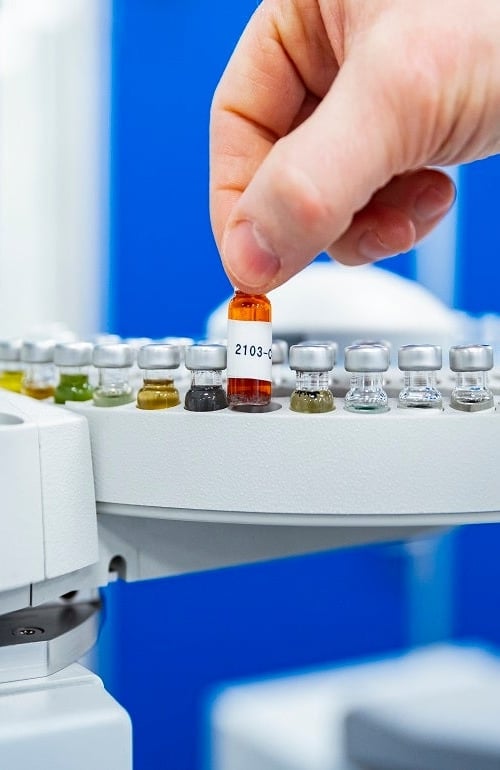
Gas analysis by ISO-certified laboratory
Receive a quote tailored to your needs
Kiwa performs both qualitative and quantitative determinations of components in gaseous fuels (natural gas, biogas and process gas) or in other matrix gases such as air. Based on the composition, the properties of these gases can be calculated, such as calorific value, Wobbe Index, density, and compressibility.
Analytical chemistry laboratory
Kiwa’s analytical chemistry laboratory offers a wide range of gas analyses conducted according to internationally recognized standards. The lab performs both qualitative and quantitative determinations of components in gases such as natural gas, biogas and process gas. Advanced techniques are used, including gas chromatography and olfactory testing for gas odor detection. The lab is ISO 9001 and ISO 17025 accredited. Standard analyses available in our analytical chemistry laboratory include:
|
Method |
Determination |
|
Gas chromatography in accordance with NEN-ISO 6974 and NEN-ISO 6975; calorific value, density, Wobbe Index, and compressibility in dry gas per NEN-ISO 6976. |
Main components and properties up to C8; Higher hydrocarbons (including aromatics) up to C14. |
|
Capillary gas chromatography with mass selective detector, per internal protocol. |
Sulfur compounds: THT, H₂S, COS, CS₂, SO₂, DMS and mercaptans; silicon compounds; halogenated hydrocarbons: chlorine and fluorine-bound hydrocarbons; scan: qualitative identification |
|
Olfactory determination of gas odor detectability using the Kiwa olfactometer. |
Gas odor detectability |
We can also analyze the following compound groups for you: aromatics, aliphatics, alcohols, aldehydes, ketones, esters, ethers and terpenes.
Do you have a gas sample and are unsure whether we can analyze it? Contact us, and we’ll be happy to discuss the possibilities.
Sampling
Prior to a gas analysis, you may perform the sampling yourself. If needed, Kiwa can supply metal sampling cylinders and/or Tedlar bags, along with sampling equipment. The sampling device is selected based on the pressure (2–200 bar) and the gas composition (clean or contaminated gas). Tedlar bags are used for collecting samples for sulfur and/or silicon compound analysis.
On-site measurements
In some cases, it may be beneficial or even necessary to have a Kiwa expert conduct measurements on-site. Examples include:
- Determination of unstable gaseous compounds
- Multiple analyses required at the same location
- Analyses for which results must be immediately available for process optimization
- Analyses to detect changes in gas composition
- Kiwa can, for example, carry out six-monthly measurements and 24-hour measurements
On-site determinations include:
- Determination of water dew point
- Determination of CO and CO₂ in combustion gases
- Ethylene (ethene)
- Total hydrocarbon content
Turnaround and reporting time
Gas analyses are completed within five working days after the sample arrives at Kiwa’s laboratory. In urgent cases, a shorter turnaround time can be arranged at an additional cost. Kiwa provides a clear and comprehensive report for every gas analysis.
Accreditation
Gas analysis is a service provided by Kiwa Technology. Kiwa Technology is part of Kiwa Expert B.V. Kiwa Expert B.V. holds ISO/IEC 17025 accreditation (registration number L469) for the analysis of main components in combustible gases (natural gas, bio methane, etc.).

Getting started with biomethane?
Want to know more about injecting biomethane? Discover the details in our step-by-step guide ‘How to start as a biomethane injector’.
Gas imaging camera: Quick and efficient detection of leaks in bio methane or biogas installations
Leaks in bio methane or biogas installations can’t only lead to dangerous situations but also pose a threat to the environment. Additionally, leaking gas represents a direct financial loss. That’s why it is crucial to detect and repair leaks and vulnerable areas in green gas and biogas systems as quickly as possible. Kiwa can assist with this by conducting camera inspections using an advanced gas imaging camera.

Analysis odorant in natural gas, hydrogen gas and other gases
Natural gas, hydrogen gas and many other gases are naturally odorless. This can cause dangerous situations, for example if a leak or other incident occurs. Gases that are distributed via the Dutch gas network must therefore be scented with a so-called odorant.
